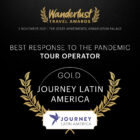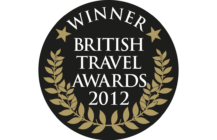Falkland Island-Hopping

Most visitors to the archipelago in the south Atlantic leave their cruise ships just long enough for tea and a piece of cake. A few spend a bit longer to experience an unlikely slice of British culture in the far southern hemisphere. But all are wowed by the flora and fauna.
These blustery, empty islands, all 700 of them, are a veritable ark of sub-Antarctic life, boasting five species of penguins, 220 species of bird, 2,000 elephant seals and hundreds of Commerson’s dolphins, playfully escorting seagoing vessels. With few land-based predators, Falklands wildlife makes a noisy and absorbing spectacle, as unconcerned with the trickle of tourists as they are with the 2,500 kelpers (as locals are called) living among them.
The best way to see the local wildlife, and to explore the Falklands, is to go island-hopping, not by yacht, but using the tiny aircraft run by the Falkland Islands Government Air Service (Figas). These aircraft land on grassy airstrips and provide an indispensable link between remote farming communities and the capital, Port Stanley. My trip involves a circuit of the outlying islands, staying as a guest of the farmers. After a day or two, I fly on to the next, to find my new host waiting beside the airstrip in a Land Rover.
At Mount Pleasant, Terence McPhee, my first host, throws my kit into the back of his Land Rover and hits the gravel road to his farm in San Carlos, my first stop in “camp” (as everywhere outside Stanley is called). The landscape is bleakly inspiring, a Shetland-like expanse of tawny grasses that undulate without end. The only trees are a pair of cypresses planted outside his farmhouse, teased into a near right-angle by the unrelenting gusts. I’ll never forget McPhee’s warning: “You’ve got to park your car properly or else the wind will blow the door off.”
My first plane hop is to Pebble Island, a large tract off the north coast of West Falkland, known for the translucent pebbles on its beaches. As I gaze from the air at these green expanses spread over an area the size of Wales, I am struck more than ever by the pioneering spirit of the 300 people who have chosen the camp life, living in settlements of one or two, running enormous farms on a quad-bike or from the saddle. “What would I want in Stanley?” one woman asks me on Saunders Island. It is a stoicism of a pre-internet age.
On Pebble Island, I know the penguins are near because I can smell them: the fishy miasma of a thousand rockhoppers, crowding on the edge of a cliff face. These fearless, bowling-pin sized birds have glided in from the sea, clawed their way up sheer rocks and have nested together in a vast gaggle of black-and-white baubles, grunting and squeaking like a broken cello.
Another endlessly watchable animal is the elephant seal. Sea Lion Island, famous for the sinking of HMS Sheffield in its waters, boasts the largest waddle of seals in the archipelago. I arrive on this flat, grassy island with two war veterans and we make straight for the beaches where the seals bask. We take our places amid heaps of coiled orange kelp, like rubbery monster entrails. Just a few feet away lie nine neckless torpedoes of blubber, their skin nicked and stretch-marked, their moist black eyes flashing. Every so often an adult male elevates its giant proboscis and whispers to its harem with a throaty gurgle. Misjudging his distance, one veteran steps too close. With more agility than you’d think possible for an animal with no visible bones, the two tonner shoots instantly into a perpendicular position, poised to knock him down in a second. We all back away to the Land Rover.
The bird that really takes me off my guard is the striated caracara. A scavenger of extreme rarity in Scotland, this falcon-like animal abounds on Carcass Island, a breathtaking little island in the far north-west of the archipelago. “The cawing drives you a bit potty but you get used to it,” says Robin McGill, in his languorous Falklands burr (somewhere between Australia and Somerset), as he drives me from the airstrip.
So large and powerful, caracaras remind me a bit of the roc of Sinbad fame, snatching objets trouvés in its powerful talons. Later I only just stop one from flying away with my clothes as I emerge from an ill-advised dip in the bay.
I arrive at last in Port Stanley half expecting a yawning megapolis from the way the outlying islanders talk about it but I suddenly understand all the tourist talk of a “relic of a bygone England”. It has swept streets and shining cottages, sweet shops and red telephone boxes. Pubs offer darts and pints of bitter. Most striking of all is Jubilee Villas, an almost bombastic terrace with double-fronted bay-windows (complete with green corrugated-iron roof), built to commemorate Queen Victoria’s golden jubilee in 1887. It must once have seemed rather out of place in this impoverished rural community. But if oil really is to come on stream, the villas won’t be out of place for too much longer.
Read more from this author at www.danielmetcalfe.com
By Daniel Metcalfe, The Financial Times Journalist.
Tailor-made holidays
Flexible, custom-made holidays to Latin America created to match your exact requirements: our tailor-made itineraries are as unique as the clients for whom they are designed.
Design my trip


























